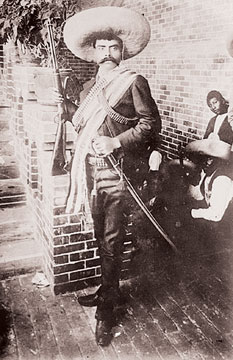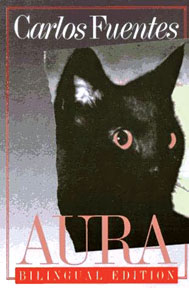|
Introduction to Carlos Fuentes:
Contemporary of Jorge Luis Borges, Octavio Paz and Julio Cortazar

 |
|
The Death of Artemio
Cruz |
Carlos Fuentes is a Mexican novelist and one of the best-known living
essayists and novelists in the Spanish-speaking world. Together with
Borges and Cortazar, he has influenced the generation of post-Boom
writers that have been studied in these weekly columns. Fuentes made his
international breakthrough with The Death of Artemio Cruz in 1962. Major
themes in Fuentes's work are the limitless power of fantasy, the dilemma
of national identity, and the promise and failure of the Mexican
revolution. Fuentes has been frequently mentioned as a candidate for the
Nobel Prize for literature.
Fuentes's upbringing was privileged. He received a cosmopolitan
education in private school and he became bilingual from an early age.
At home his father made him read Mexican history, which he saw as one of
crushing defeats compared with that of the United States. "I learned to
imagine Mexico before I ever knew Mexico", Fuentes once said. At the age
of 16 he returned there, where he attended the prestigious 'Colegio de
México'. He then entered the School of Law at the National University of
Mexico, receiving his LL.B. in 1948. He also studied economics at the 'Institut
des Hautes Études Internationales' in Geneva. During his university
years, Fuentes became a Marxist and joined the Communist Party. In 1959
he married the famous Mexican actress Rita Macedo. They had a daughter,
Macedo, "dark-skinned, with large, almond-shaped eyes and prominent
cheekbones," as Fuentes described her, who appeared in the last scene of
Luis Buñuel's 'Exterminating Angel'.
From 1959 Fuentes devoted himself to writing. During the 1960s he
lived mostly in Europe. His third major novel, 'Cambio de piel' (1967, A
Change of Skin), which depicted a group of people on a journey from
Mexico City to Vera Cruz, won a prestigious prize in Barcelona, Spain.
However, the book was criticized as "pornographic, communistic,
anti-Christian, anti-German and pro-Jewish" and censors did not allow
its publication in Spain. Due to his political views Fuentes was
'persona non grata' in the United States and was forbidden to enter
Puerto Rico. He protested against the Mexican government's brutal
repression of the student revolution in Tlatelolco Square before the
Olympic Games in 1968 and was exiled to Paris. In 1971 along with other
leftist intellectuals and labor leaders he attacked the dominant 'Partido
Revolucionario Institucional', or PRI. In A 'New Time For Mexico' (1994)
he described President Carlos Salinas de Gortari's economic policies as
"archaic, savage capitalism, concentrating wealth in the hands of a
minority and waiting for the impossible miracle of trickle-down."
 |
|
Carlos Fuentes |
From 1974 to 1977 Fuentes served as the Mexican ambassador to France.
He has been a teacher and fellow at various universities, including
Columbia University, New York, the University of Pennsylvania,
Philadelphia, Princeton University, New Jersey, and Harvard University,
Cambridge, Massachusetts. He has been often been paired with the
Argentinian writer Jorge Luis Borges, of whom he has also written." He
seemed to literally look inside himself, as if this were the only thing
that counted in matters of sight," Fuentes wrote in 'Borges in Action',
"seeing outside being a totally frivolous affair." Whereas Borges uses
history as a basis for pure fantasy, Fuentes maintains a realistic
stance on power and politics in Latin America - myths of the past and a
wide range of cultural references are combined with social critique.
Fuentes also uses experimental techniques familiar from the nueva
novella (new novel) and postmodern fiction. In later novels Fuentes has
dealt with the question of Mexican identity and its relationship to
other cultures.
'The Death of Artemio Cruz' is told in the first, second, and third
person. Artemio Cruz is a poor peon (peasant) and supporter of
revolutionary ideals. He gains wealth and becomes a corrupt,
ruthlessness business magnate, a symbol of international capitalist
greed. As he lies on his deathbed, Fuentes follows his fragmented
thoughts and images, wavering between past and present.
The haunting novella 'Aura' (1962) is told in the second person
narrative. The reader and the fictional protagonist are united in a
story which deterministically leads to change of identities. A young
historian, Felipe Motero, starts to complete the memoirs of General
Llorente in a strange, old house.
He falls in love with the beautiful young Aura. She is the niece of
his employer, Señora Consuelo, the widow of the general. Eventually
Felipe finds his reincarnated identity and Consuelo tells him that Aura
is the projection of her younger self. Fuentes started to write the
novel in Paris, which he has called a double city.
In the story Fuentes recreated a girl he had met as a child in Mexico
and years later again in Paris: "She was another, she had been another,
not she who was going to be but she who, always, was being."
 |
|
Aura by Carlos Fuentes |
'Terra Nostra' (1975) is concerned with the history of Spain and of
South America, with the Indian Gods and with Christianity, with the
birth, the passion, and the death of civilizations. It moves freely in
time from ancient Rome to the apocalyptic end of the 20th century. "Time
is the subject matter of all my fiction", Fuentes once said. One of the
main settings is the 16th century Spain, where Philip II constructs the
monastery-palace of El Escorial. 'El gringo viejo' (1985, The Old
Gringo) was a love triangle drama of an American woman, Harriet Winslow,
Tomás Arroyo, a general, and the American journalist and writer Ambrose
Bierce, who disappeared during Pancho Villa's revolution in 1913. "She
sees, over and over, the specters of Tomás Arroyo, the moon-faced woman
and the old gringo cross in her window. But they are not ghosts. They
have simply mobilized their old pasts, hoping that she would do the same
and join them." The book was filmed by Luis Puenzo in 1989, starring
Jane Fonda and Gregory Peck.
In 'Instinto de Inez' (2001) Gabriel Atlan-Ferrara, a symphony
conductor, realizes at the age of 93, that the future, for him, means
death but in the past are love and Inez; eternity. Like Artemio Cruz at
the end of his life, Garbriel studies the choices he has made in his
life. At the centre of the story is a mystic crystal seal which unites
space and time.
Fuentes' ability to write short stories has been acclaimed by
critics, although his short fiction has generally received less
attention than his novels. Nevertheless, his overriding literary
concerns are the same in both genres. He explores the issue of Mexico's
national character and attempts to firmly establish the country's
cultural identity. To accomplish this, he incorporates myth, legend, and
history into his work, probing the past events of his homeland and the
essence of modern Mexican society. His short fiction features unusual
treatments of time and the use of fantastic, seemingly supernatural,
events. He is also known for the ironic twists that he frequently places
at the conclusion of his short narratives. It is his deft handling of
this classic short story tool that has helped to establish his strong
reputation as a highly influential writer.
|

